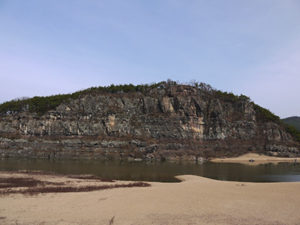


古民家探訪記から木造の歴史探訪のような展開になってきたわたしのブログ。
もともとの歴史好きが住宅に関わってきたことから
興味の行方としてはまぁ、ごく自然な展開なのだろうと思っています。
それで「日本のいい家」シリーズを続けているのですが、
多少は国際的な比較対照も考えてみたいと2016年には韓国を訪問した。
民族の住文化に敬意を表して「安東・河回村」を見学した次第です。
何回か触れても来たのですが、今回ちょっと深掘り型で探究したいと思います。
まずは村の案内として現地に置かれていた看板表示・日本語解説から。
〜「河回村」 重要民俗資料・第122号。
この村は豊山・柳氏が600余年間代々暮らしてきた韓国を代表する「同姓村」で
茅葺きと瓦葺きの家々が悠久の歴史の中で良好の状態で保存されてきました。
とくに朝鮮時代の大儒学者である柳雲竜、文禄の役の際の政権トップであった
柳成竜の兄弟が誕生した村として有名です。
河回村という村名は洛東江がS字型に村を囲むように流れていることに由来する。
河回村は風水地理学的に太極形・蓮華浮水形・行舟形に該当し朝鮮時代にはすでに
人が住むのに最適な場所として名をはせました。
村の東方には太白山から連なる海抜327mの花山があり、その裾野が丘を形成し
村の最西端まで続く。村の中心の一番高い位置に樹齢600年を超える
三神堂と呼ばれるケヤキの木(御神木)があります。
河回村の家々はこの三神堂というケヤキを中心に川に向かって配置されているため、
家々の向きが一定ではない。韓国の他の村では家の方向が真南もしくは東南と
一定方向を向いているのとは非常に対照的であると言えます。
また瓦屋根の家々を周辺の藁葺屋根が円形に囲むように配置されている点が特異。
河回村では庶民の遊びである河回別神グッ仮面舞やソンビ(学者)の風流な遊び、
韓国伝統花火「ソニュウチュルブルノリ」が現在まで伝承されており、
韓国の伝統生活文化や古建築様式を残す文化遺産が今も尚よい状態で保存。〜
この日本語の案内文は非常にわかりやすく書かれています。
長い隣国関係を表現しているようにも思われますね。
上の写真は河回村全体を見渡せる「芙蓉台〜プヨンデ」からの全景と
村側から見返す芙蓉台の様子。芙蓉という東アジア共通語が強く印象される。
この手前の川が「洛東江」であり、釜山(金官加羅)港に注ぐ大河川上流。
河川交通の要衝地でもあったのだとわかりますね。
内陸に位置しながら、水運を通して広く世界と繋がっていたのだと思います。
あす以降地誌・建築、日本との関係史なども織り交ぜながら
書き進めてみたいと思います。
English version⬇
[Recollection of Andong Hahoe Village, Gyeongsangbuk-do, South Korea-1]
My blog has evolved from an old folk house exploration record to a wooden history exploration.
Because the original history lover has been involved in housing
As for the whereabouts of my interest, I think it’s a very natural development.
That’s why I’m continuing the “Good House in Japan” series.
I visited South Korea in 2016 to consider some international comparisons.
I visited “Andong Hahoe Village” in honor of the ethnic living culture.
I’ve touched it several times, but this time I’d like to explore it in a deeper way.
First of all, from the signboard display and Japanese commentary that was placed on the site as a guide to the village.
~ “Andong Hahoe Village” Important Folklore No. 122.
This village is Korea’s representative “same surname village” where Mr. Toyoyama and Yanagi have lived for more than 600 years.
Thatched and tiled houses have been preserved in good condition throughout their long history.
In particular, he was the top government in the role of Bunroku, a great Confucian scholar in the Joseon Dynasty.
It is famous as the village where the brothers of Seiryu Yanagi were born.
The name of the village, Andong Hahoe, comes from the fact that the Nakdong River flows around the village in an S-shape.
Andong Hahoe Village corresponds to the Taiji, Lotus Flower Floating, and Boat Shapes in Feng Shui geography, and was already in the Joseon Dynasty.
It has made a name for itself as the best place for people to live.
To the east of the village is Hanayama, which is 327m above sea level and extends from Mt. Taihaku, and its base forms a hill.
It continues to the westernmost tip of the village. Over 600 years old at the highest point in the center of the village
There is a zelkova tree (Shinboku) called Sanjindo.
The houses in Andong Hahoe Village are located toward the river centering on the zelkova called Sanjindo.
The orientation of the houses is not constant. In other villages in Korea, the direction of the house is southeast or southeast
This is in stark contrast to pointing in one direction.
Also, it is peculiar that the houses with tiled roofs are arranged so that the surrounding thatched roofs surround them in a circle.
In Andong Hahoe Village, the common people’s play, the Kamen Mai of the Goddess of Hahoe and the seonbi (scholar)’s style play,
The traditional Korean fireworks “Sonyuchuruburunori” have been handed down to date.
The cultural heritage that preserves Korean traditional life culture and ancient architectural style is still preserved in good condition. ~
This Japanese guide is very easy to understand.
It seems to express a long relationship with neighboring countries.
The photo above is a panoramic view from “Fuyodai-Puyoungde” overlooking the entire Andong Hahoe Village.
The state of Fuyodai looking back from the village side. The common East Asian language of Fuyo is strongly impressed.
The river in front of this is the Nakdong River, which is the upstream of a large river that flows into the port of Busan (Gaya).
You can see that it was also a key point for river traffic.
Although it is located inland, I think it was widely connected to the world through water transportation.
After tomorrow, while interweaving geography, architecture, history of relations with Japan, etc.
I would like to continue writing.
Posted on 8月 19th, 2021 by 三木 奎吾
Filed under: 住宅マーケティング, 歴史探訪







コメントを投稿
「※誹謗中傷や、悪意のある書き込み、営利目的などのコメントを防ぐために、投稿された全てのコメントは一時的に保留されますのでご了承ください。」
You must be logged in to post a comment.